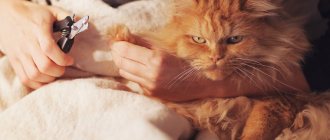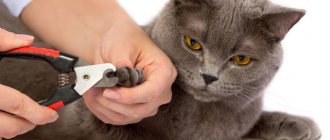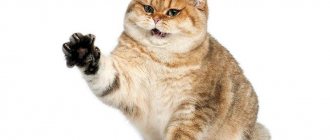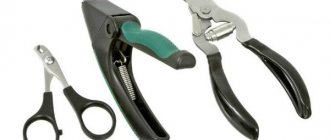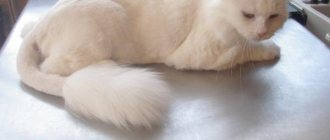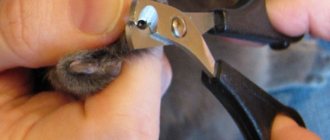What will you learn from the article?
- How to trim a cat's claws correctly?
- 8 tips on how to trim a cat’s claws How to prepare for the first procedure
- Nail trimming tools
- How often to trim a cat's claws
- What not to do
A cat's claws grow throughout their life and are continually renewed. To speed up and facilitate this process, cats need to sharpen their claws by scratching objects that are not always suitable for this. And during play, cats very often injure their owners with sharp claws.
Is it possible to trim a kitten's claws? The answer is yes. In this article you will learn how to trim a cat's claws.
Nail trimming process
Be sure to look at the photo to see where to cut the nail correctly so as not to damage the pulp. Let's get started:
- Gently press down on the pad of the paw, exposing the claw. Hold in this position. Take a nail cutter and cut off the overgrown claw at a distance of no more than two mm from the pulp with a smooth movement.
- Then treat all the claws on the paws, not forgetting the fifth toe. Place the cutting part of the forceps perpendicular to the claw from top to bottom.
- If necessary, polish the trimmed nails with a nail file.
Try to avoid injury to the pulp during trimming, do not cause pain or discomfort to your beloved animal, as next time the cat will more actively protest against trimming the claws.
After finishing the claw trimming, be sure to stroke, caress the cat, and give her her favorite treat. Such sessions should be carried out once a month, depending on the intensity of claw growth.
How to trim a cat's claws correctly?
There is nothing complicated about this procedure; you can handle it yourself.
If the procedure is carried out correctly, your pet will not have any unpleasant impressions, and he will not get nervous and break out at the sight of scissors or if the procedure needs to be repeated.
Before you trim your cat's claws, you need to prepare tools, a hemostatic agent, and cotton pads.
First you need to determine where the blood vessel ends on the claw.
The claws are transparent, so if you hold them up to the light, this place will be clearly visible.
If a blood vessel is touched, bleeding will occur, and then inflammation may develop.
Claw diagram
If the location of the blood vessel is very close to the end of the claw, then you can shorten it a little.
If necessary, you should take your pet to the veterinarian; a convenient carrying bag will help make this visit comfortable for your pet.
The cutting process itself looks like this:
- The cat should be placed on your lap. If you can’t handle it yourself, you can invite an assistant to hold the pet. You need to talk to the animal tenderly and pet it in order to distract you from the procedure itself.
- You need to press on the pad of the paw with your thumb to make the claw appear. It is better to make a transverse cut, so the animal will not feel discomfort.
- Trimmed areas need to be polished. An ordinary nail file is suitable for this. Before you trim your cat's claws, you need to prepare this nail file.
With infrequent trimming, the claws begin to interfere with the pet
Important! If a vessel was accidentally touched and bleeding began, it must be disinfected with an antiseptic. If the bleeding does not stop, you should immediately take your pet to the veterinarian.
Why does a cat need long claws?
Complete freedom of action The cat does not need long claws - the main thing is that they are sharp and do not peel off.
Therefore, it is possible or even necessary to trim cats’ claws. But you need to know that under natural conditions, any normal cat does its own “manicure” - sharpens its claws. Moreover, free animals do not even need to specifically look for a “sharpener”: the “manicure” is done in the process of climbing trees. In addition, cats tear up furniture not only for the sake of “manicure”, this is how they mark their territory. In the area of the pads on their paws, cats have glands that secrete a secretion that is a message to the rest of the animals. Therefore, those owners who think that a “manicure” will save their home furniture from damage are very mistaken - their pet will still peel off the upholstery, it’s just that the stripes will become less deep.
Nail trimming: necessity or fashion trend?
It’s a completely different matter for an animal that does not encroach on the furniture and hands of its owner. “Why trim a cat’s nails if she doesn’t scratch?” - many people think. In fact, such a procedure is often needed not so much by the owners as by the furry purrs themselves. Their claws grow throughout their lives. If the animal does not have the opportunity to grind them down naturally, then the claws curl and dig into the paw pads, injuring the delicate skin .
A claw that is too long can get caught in a curtain or bedspread. As a rule, the animal cannot get out on its own. At best, the owner will free him. But it also happens that in an attempt to escape, a cat cripples itself, literally pulling the claw out of its “finger.”
In some cases, you can avoid an unpleasant procedure by buying your pet a scratching post or simply bringing a suitable board into the house. But these half measures do not always help.
Rules for cutting nails
Many people are concerned about whether a cat can have its claws trimmed? After all, if you think about it, they are the animal’s natural defense. Moreover: during the procedure, most animals struggle so much that there is a real risk of injury. Veterinarians are unanimous on this matter: it is necessary to trim the claws, but it must be done correctly .
- The main thing to remember: you can’t use either the tools from the manicure set or regular scissors . They are designed for a different nail shape, and the cat's claw can be injured. There are special devices - nail clippers. They are produced in two types: standard nippers and guillotine-type nippers. Both are easy to use, so the choice depends entirely on your preferences.
- In the part of the claw closest to the finger there is a blood vessel - the pulp. If you catch it, the animal will experience severe pain, and a drop of blood will appear on the cut. The result may be inflammation and infection of the wound, not to mention the fact that the next time the cat will desperately resist the haircut. Take the claw and look at it carefully against the light. You will clearly see a pink vessel and a whitish, transparent part with a depression in the middle. It is this that will need to be shortened.
- Some cats have black claws. In this case, it is almost impossible to determine where the live part begins. Therefore, it is better to cut off only the very tip.
- Don't forget that there are five toes on the paw: four on the pad and one at the back. It also needs to be trimmed. Moreover: even for cats that spend most of their time outside, it needs to be shortened from time to time. The fact is that it is practically not used and, accordingly, does not wear off even in the most active animals.
- to the question of how often to trim a cat’s claws . It all depends on the growth rate of the horny plates. As a rule, the optimal interval is from 2 weeks to 1 month.
- Although the process of claw trimming is completely safe, not every cat needs it. For an animal that lives in a private home and spends a lot of time outside, claws are vital. Without them, they will not be able to climb a tree or protect themselves from a tailed rival or a dog. And a meeting with a rat without natural cat weapons can even become deadly. Most freedom-loving tramps grind their claws down on their own in the process of climbing trees and walking on asphalt. House cats who do not leave the apartment find themselves in a different situation. Regular nail trimming is absolutely necessary for them.
Why trim your cat's claws?
It is necessary to trim your cat's claws for several reasons:
- this will partially solve the problem of damaged wallpaper and furniture;
- this is necessary for the cat itself, because overgrown claws increase the risk of injury: they can get stuck or break somewhere, causing discomfort to the cat, and can even grow into the paw pads;
- For purebred cats participating in competitions or exhibitions, untrimmed claws may be a reason for disqualification.
Grooming should only be done on cats that live permanently at home and are not outdoors. If your pet regularly goes outside or lives in the country, there is no need to do this, since such pets usually grind their claws on asphalt, stones, and tree bark. They also use them as protection and for hunting - without them the animal becomes vulnerable.
At what age should you start trimming your nails?
Nowadays there is a widespread opinion that the sooner you accustom your cat to the procedure of claw trimming, the better. This is partly true, but only partly. It is completely pointless to approach kittens that are two or three months old with special scissors. Their claws simply haven’t had time to form yet.
The soft claws of very young kittens do not need correction
An analogy can be drawn with teeth - there is no point in going to pull out baby teeth, since they will fall out on their own and make room for new ones. Of course, kittens’ claws will not grow, but during the first months they are renewed without anyone’s intervention due to their softness. By the first two months, only the first “hints” of keratinized epidermis form on the kittens’ paws. It makes sense to correct it only if there is a risk of injury to the kitten, which occurs very rarely.
You should start thinking about trimming nails when your pet reaches six months of age.
Closer to six months, when the kitten’s body gradually takes on its final shape, and the body gradually completes active development, it makes sense to take up the scissors and accustom the “young people” to this difficult procedure. Trying to trim nails too early will not necessarily lead to quick habituation. On the contrary, if you are careless and damage your kitten’s already fragile claw, he will remember this for a long time.
How to trim a kitten's claws?
- Catch the moment when the kitten has had enough of playing, running around and is now about to go to bed. This is when he is most relaxed and receptive. If you pick up a kitten at the peak of its game, it will begin to break out in every possible way;
- Throughout the procedure, talk to the kitten in a quiet and calm voice. Kittens do not understand human words, but they perfectly catch intonations. Nervousness in the head or haste will be transmitted to your pet as quickly as calmness and confidence;
- Do not start the procedure right away. Hold the kitten in your arms and let him get used to this position; Remember that he must feel that you are not going to hurt him;
- Using your index and middle fingers, gently press the pad so that the kitten releases its claw. Examine it and determine exactly how you will hold the nail clipper so as not to injure the animal;
- Place the nail cutter from top to bottom so that it is perpendicular to the claw being trimmed and trim the claw at a distance of one or two millimeters to the pulp (it has a pinkish tint);
- If it turns out that you cut off an extra part of the claw and a little bleeding begins, do not panic. Use hydrogen peroxide to treat the wound and prevent bacteria from entering;
- If you see that you did not cut your nail very neatly, use a special nail file to correct the situation. But do not try to grind off too much of the epidermis - the kitten will immediately feel pain and begin to struggle;
- Reward the kitten for the “feat” he has experienced with his favorite treat.
Keep in mind that the first time, the kitten may simply not be able to wait until the end of the procedure and begin to struggle. Few adult cats can sit until the end without moving, let alone young, full of energy kittens. You can start by treating one paw at a time, then gradually move on to two, and so on.
It is advisable to start the procedure with a positive attitude from both the cat and the owner.
When trimming nails, it is important to adapt to your pet’s mood. If he breaks free and wants to run away, let him do it.
This is probably due to poor use of the nail clipper and touching the sensitive part of the claw. Perhaps you've come across a hyperactive cat who can't sit still for more than a minute. Situations are different - the main thing is to choose the right approach in time.
If the cat is not given?
Cats, like people, have different types of personalities. There are particularly nervous and aggressive animals that do not even allow the owner to touch their paws. Alternatively, nail trimming for these pets should be done by two family members, one holding the cat and the other trimming the nails. You can also swaddle your pet with a soft towel or sheet.
If the cat still behaves aggressively and stubbornly breaks out, you should not use force, since trimming the claws can lead to paw injuries. It is better to interrupt the procedure and do it when the pet is in a calmer state.
Do you need to cut your cat's nails?
If a cat spoils furniture, does not want to use a scratcher, shows aggression towards people, or its claws do not grow properly (this happens quite often), then it is better to trim them.
Sometimes, even while playing with the owner, the cat cannot control the dangerous weapon, clinging to surrounding objects and injuring the person, risking simultaneously injuring himself.
If there are several cats in the house, they are constantly running around, fighting, injuring each other, you should trim their claws.
Anatomy of claws
A cat's claw is a complex system consisting of muscles, joints, tendons and ligaments. This allows the animal to release it and hide it again.
The visible part of the claw consists of 2 parts: the cornea and the pulp - the living part with blood vessels and nerve endings. Only the upper cornea can be cut off; touching the pulp is strictly prohibited. To do this, it is enough to remove only 2 mm of the tip of the claw.
Periodically, the old layer in the form of a cover is removed from the claws. The fifth claw on the front paws is located on the back side and is never worn down. Over time, it can curl up and grow into the skin.
In what cases is it necessary to cut your hair?
When a pet lives in the house and does not go outside, it does not need protection
He has everything for a comfortable life - housing, food, water, attention. In this regard, the most dangerous weapon of a cat is often used for other purposes, causing harm
A strongly overgrown claw bends and hurts the pads of the cat's toes when walking. Breeders are recommended to introduce kittens to nippers from childhood, then problems will not arise in the future.
If the cat is an adult, and the claws need to be trimmed for the first time, you need to be patient to accustom him to grooming. Regular pruning does not require complex skills and it is quite possible to do the procedure yourself at home.
Anomalies: detachments, bifurcation of the claw
When there are no irregularities in the pet’s diet and the claws are cut when necessary, a scratching post is placed in the house, but the claws continue to split or bifurcate - this is a reason to worry about the health of the animal. If a cat periodically limps and does not allow its paws to be touched, this indicates defeat.
In case of injury or improper pruning, infection can penetrate into the soft tissue. This inflammation is called paronychia, and when suppuration forms, it is called pyongychia. In this situation, the most correct decision is to visit a veterinarian in order to:
- getting your pet tested;
- making an accurate diagnosis and prescribing treatment.
Often, an infectious lesion requires a course of antibiotics, or even an operation - opening and draining the infected wound, removing the claw.
Another reason for nail splitting is their abnormal growth. As a rule, this happens in old animals when the thyroid gland produces too many hormones.
Pathologies should also include fungi. They arise under the influence of injury or improper haircut. The main signs of fungal infection:
- unnatural color;
- compaction and thickening;
- swelling and hyperemia around;
- pain in the paw, causing the cat to limp;
- The cat often licks and bites his paw.
What to do if the claw is in the way?
If the owner constantly notices the cat’s discomfort when claws cling to the carpet, upholstered furniture, etc., you need to check the pet’s claws. Perhaps this is a sign of their excessive growth and the need for trimming.
Other reasons
There are other reasons for trimming a cat's claws. For example, a pet damages furniture and shoes, does not respond to scratches, and can scratch the owner or other residents of the apartment, especially if there are small children in the house.
If nails grow abnormally, trimming them is necessary.
Useful video
Here are a few more tips to help you avoid making mistakes when trimming your kitten's nails.
Under no circumstances should you start trimming a cat’s claws if the animal is struggling violently. Otherwise, you may injure your furry. And more aggressive pets can even scratch their owners. It is ideal if the kitten is as calm, relaxed and even a little sleepy as possible before trimming its claws.
Blood appears if you overdo it with claw trimming. If you touch the pulp, you can cause minor injury to your pet. Under no circumstances should you worry or panic.
Here it is important to gather yourself and disinfect the wound as quickly as possible. To do this, use hydrogen peroxide, which will prevent infection and at the same time quickly stop the bleeding.
Distract and calm the kitten to protect it from unnecessary stress.
Veterinarians recommend, and here I agree with them, that your pet needs a manicure as its claws grow. Most often, the procedure is repeated every 2-3 weeks.
If you accidentally cut the living part of the claw or the skin on the pad, then the main thing here is not to panic. If there is a small amount of blood coming out, just gently treat the bleeding claw or wound with hydrogen peroxide and calm the offended pet.
If, without keeping an eye on your pet, he jerks unsuccessfully and the bleeding from the wound is abnormally strong, immediately cover the cut with a clean piece of tissue and take the cat to the veterinarian.
Tools
What you need for work:
- Scissors. Necessary for cutting off excess hair that interferes with visibility.
- Special nippers. It is better to use a tool designed for cutting claws - a nail clipper - this will be convenient for the owner and comfortable for the pet.
- Cotton wool and hydrogen peroxide. Useful for stopping bleeding.
- Manicure file. It will help remove roughness if the nail is not trimmed the first time.
- For particularly restless cats, there are restraint bags. In extreme cases, the animal can be swaddled like a baby.
How to trim a kitten's claws?
In kittens, the pulp takes up most of the nail
Therefore, you need to be careful when trimming the nail tips of babies. Haircuts must be carried out taking into account the following instructions:
First of all, the owner needs to wait until the baby is calm and well-fed. Then the animal needs to be picked up and caressed
It is imperative to pay attention to the pads of the feet: they should be stroked, lightly pressing on the toes. After the pet gets used to such movements, you need to press on the pad so that the marigolds appear from it. The very tip of the nail is placed in the nail clipper; you need to ensure that there is a margin of 1-2 millimeters to the pink area. The marked area is carefully cut off. Each claw is processed in the same way. Only the very tip of the kitten’s claw can be trimmed.
If the owner accidentally damages the pulp, the emerging blood must be soaked with a cotton pad and the cut treated with hydrogen peroxide
You can only trim the very tip of a kitten's claw. If the owner accidentally damages the pulp, the emerging blood must be soaked with a cotton pad, and the cut must be treated with hydrogen peroxide.
This video shows how to trim a cat's claws.
How to trim a cat's claws?
To trim a cat's claws, only specialized tools should be used, and ordinary scissors should be abandoned. The best option for cutting is to use a blister. This device resembles regular nail scissors, but its blade is shaped to fit a cat's nail. In addition to blisters, you can use nail clippers, which in their appearance resemble
- The pet needs to be placed using forceps or pliers. Basic rules: kneel and caress;
- by gently pressing on the pad, you need to get the marigolds out;
- using special accessories, 1-2 millimeters are cut from the nail edge: you can cut only the upper part of the nail, otherwise the pulp may be damaged, causing the animal to feel severe pain;
- According to similar instructions, all nails of the front and hind paws are trimmed;
- the treated claws are filed with a manicure file;
- then the sections are treated with an antiseptic solution.
To make your pet feel comfortable next time, you can treat him to his favorite treat after the haircut is complete.
How often should you trim your nails?
Claws should be trimmed as they grow back: most often this period takes 2-3 weeks. Trimming the nail plates of kittens is most often done once a month. It is worth considering that you cannot take long breaks between trimming, otherwise your pet may get out of the habit of it and react aggressively to the resumption of such manipulations. You can skip treating the nail plates only if the animal is sick, or if it is in an irritated or stressed state. However, after stabilizing his health, it is necessary to immediately trim his claws.
This restriction does not apply if the pet regularly participates in competitions or exhibitions. The provisions of these events oblige all owners of participants to trim their pets' nail plates before each professional inspection. In case of complete or partial failure to comply with this most important condition, the participant will be disqualified from the event.
This video talks about whether or not cats need to have their nails trimmed. Don’t forget to leave your questions and suggestions for the article.
Technique of the procedure
The owner will have to trim their claws regularly, so before the procedure it is important to know how to trim a cat’s claws correctly. Stages of the mandatory procedure:
- Wash your hands well and sterilize the instrument.
- Hold your pet firmly and press on the paw pads until the claw appears.
- The device must be directed at right angles to the desired nail (direction from top to bottom).
- If the animal has a light-colored claw, then it needs to be trimmed within 1-2 mm of the pink area. For cats that have pigmentation, trim 1-2 mm from the tip of the nail so as not to damage the capillaries. If the pet has dark claws, they are trimmed in stages to avoid bleeding.
- Trim the claw in one motion.
- Sand the cut area with a nail file and treat with an antiseptic.
You should not keep your cat in an awkward position for a long time, as this can make her nervous.
It is important to know that if a capillary was touched during the procedure, then a bandage or cotton wool moistened with hydrogen peroxide must be applied to it. In addition to this remedy, you can use Chlorhexidine
If you cannot stop the bleeding, you should contact your veterinarian. But usually such manipulation, if you have the proper experience, is quick and painless.
Owners of the Persian or Siberian cat breed will need a special hair clipper. These animals have a lot of hair near their paw pads. They prevent safe nail trimming. If your pet is frightened by the noise of the device, you can cut the hair using scissors. After the procedure, you can treat your pet with his favorite treat. Also, the animal must be praised for its exemplary behavior during the procedure.
How to trim your nails yourself?
Any veterinary hospital provides nail trimming services. However, for many animals, going to the clinic is a huge stress. To rid your pet of it, you can perform the unpleasant procedure yourself. To trim your nails at home, you will need:
- Claw clipper.
- Nail file.
- Cotton pads and hydrogen peroxide in case you accidentally injure the animal.
Take the animal in your arms or place it on the table in such a way that it has no opportunity to escape. There is no need to fix it too tightly. The cat must feel safe, otherwise its resistance will become even more violent. At the same time, make sure that your pet does not jerk while cutting the nail.
It is most convenient to carry out this procedure together, although this depends on the nature of your animal and your relationship with it. Some cats tolerate nail trimming completely calmly, while others can be difficult to handle even for several experienced veterinarians. And some animals allow you to do whatever you want with them, but only as long as they are in the arms of their beloved owner.
With your cat secured, take the paw and lightly press the pad between your toes to extend the claws. Find the place where the vessels end and carefully trim the claw perpendicular to the direction of its growth. Treat all toes in this way, including those on the back of the paw.
If possible, it is better to clean the cut edge a little with a nail file. Not all animals allow this, so if the cut is smooth, straightening can be neglected. The exception is hairless cats: a sharp edge can scratch the skin almost as deeply as a whole claw.
At what age should a kitten's nails be trimmed?
All pet care guides recommend trimming your pet's nails as needed. How to determine that such a need has arisen? With dogs, everything is simpler; if the dog’s nails are knocking on the floor or the dog’s fingers are moving apart, it’s time to cut it. For cats, the need is determined at the discretion of the owner.
Indications for urgent nail trimming are:
Bend the claw in the opposite direction - when the claw grows too long, it bends with the tip towards the pad.
Injuries and cracks in the claws - it is better not to trim them without consulting a veterinarian.
Claw delamination occurs due to vitamin deficiency or fungal infection. If a cat has a fungus, it is necessary to remove as much of the infected tissue as possible. It is better to entrust the procedure to a veterinarian.
Many owners have a question: at what age should a kitten’s nails be trimmed? It is important to understand that trimming the nails of an adult cat who is not familiar with this procedure is quite difficult. This is why a kitten is taught to use nail clippers from early childhood.
It is up to the owner to decide whether to trim the claws or simply rehearse this procedure. There is rarely a real need to trim the nails of small kittens.
Trimming the nails of a newborn kitten
Newborn kittens are born with their eyes and ears closed, without teeth, but with claws. Surprisingly, the claws of newborn kittens are quite sharp. Since babies cannot walk, they crawl along the litter, clinging with their claws.
The nest of a cat with kittens must be covered with smooth fabrics that are difficult to catch with claws, for example, cotton, linen, chintz. If terry cloth is used as bedding, the kittens will cling with their claws, which can cause injury to their fingers.
The need to trim the claws of a newborn kitten arises if you are feeding an orphaned baby. Being with their mother, even kittens in trouble can count on help and support. Even if the cat cannot free the baby on its own, it will meow and call for help. A similar situation with a kitten left unattended by its mother can result in injury and hypothermia.
Trimming a kitten's claws at 1–2 months
When babies turn 1 month old, they begin to actively explore the world around them. During this period, nail trimming is strictly not recommended as kittens learn to walk, balance and control their own fingers. When a kitten runs or performs any maneuvers, it consciously releases its claws or holds them in the pads.
At 2 months, kittens’ claws retain their sharpness and noticeably grow in length. Since at this age babies still drink their mother's milk, their claws can cause injury and irritation to the skin of the nipples. This is the only reasonable reason why a two-month-old kitten needs to have the tips of its claws trimmed. However, it is from 2–3 months of age that it is recommended to begin (rehearsal) training kittens to use nail clippers.
How to trim a kitten's claws - nail clippers and improvised tools?
Let's say you have an urgent need to give your pet a manicure. How to trim nails yourself without harming your pet? If you have a nail clipper, the task becomes easier. If the kitten is about to have its nails trimmed for the first time, and you don’t have the tools, you can use improvised media while observing safety precautions.
Important! Don't set yourself the task of trimming all of your kitten's nails at once. If you were able to cut one claw in one approach, this is already a success.
Regular scissors
The first thing that comes to the mind of an inexperienced owner is to trim the pet’s claws with ordinary scissors, but is this possible? Hypothetically, you can...if:
- The cat will not twitch.
- You have a steady hand.
- The cat has thin claws.
- You only need to trim the ends.
What could go wrong? The structure of a cat's claws is significantly different from that of a human. When using regular scissors to trim nails, there is a very high probability of:
- Crushing a claw is very painful.
- Injuring your finger if the cat pulls its paw is even more painful.
Have you injured your pet unknowingly? In such a situation, it is extremely important to quickly stop the bleeding and ensure that the wound does not become infected. The injured claw will grow back, after which it needs to be trimmed. If the wound looks serious or your finger is injured, it is best to consult a doctor. If you don’t have nail clippers at hand, and your claws urgently need to be shortened, it’s wiser to use a nail file or nail scissors.
Nail scissors
A small kitten (1-3 months old) can have its nails trimmed with nail scissors. The only nuance is the model of the scissors. Nail scissors can be distinguished by their tips:
- Curved - for cuticles.
- Direct.
- Rounded – safe for cutting off hangnails and corners of nails.
Nail scissors with rounded tips are suitable if the nails need to be blunted rather than trimmed. Simply put, if you only need to cut off the ends so that the baby does not cling to the bedding and injure himself, you can hold off on buying nail clippers.
Can nail clippers be used to trim nails?
Nail clippers (for humans) are one of the most common tools used by inexperienced owners to injure cats. To painlessly shorten your pet's claw, you need to cut it at an angle. The blades of the tweezers close straight, but in order to set them at the desired angle, the cat's paw will have to be bent at an unnatural angle.
Again, if your pet has an exceptionally calm temperament and lies motionless in any position during the procedure, tweezers are suitable. If the pet jerks its paw when the claw is caught between the blades, it will be injured. By the way, if you use tweezers, even veterinary ones, the pressure on the handles should be firm and sharp. By cutting the claw slowly and smoothly, you risk crushing it.
How to use a guillotine correctly
Have you bought nail clippers and don’t know how to use them? The good news is that the guillotine is easy to use and the procedure is safe. The second news is that you probably won’t be able to trim all the claws the first time.
First, check your pet's reaction by touching the guillotine to the claw. Click the claw clipper and watch the reaction again. If the cat does not pull back its paw, you can try cutting it. Be sure to hold your pet's paw with your free hand. Cut off only the tip (sharper) of the claw. Your movements should be confident and firm. The guillotine cuts the claw at an angle, so the pet should not experience any discomfort.
Regularity of the procedure
The interval between manipulations should be carried out as the claws grow. In addition, if a cat has light-colored claws, then he needs to trim them more often. Dark claws with pigmentation grow more slowly. Active or outdoor animals do not need pruning at all.
On average, a domestic cat needs trimming once a month. If a young animal lives in the house, then a haircut should be done once every 2 weeks. At this age, claws grow faster than those of older cats. You should not skip this procedure, as the pet will get used to it very quickly and the owner will have to accustom him to the unpleasant manipulation again. If an animal is to compete in a competition, its claws must also be trimmed. Otherwise, the cat may be excluded from the competition.
Haircut alternatives
A cat can grind its claws down on its own if it gets a good scratching post and gets used to it.
There is a more radical option for dealing with claws - removing them completely. However, this procedure is not painless. The operation is performed under anesthesia. Although the animal will recover quickly, it will continue to experience stress for a long time.
Such an operation is extremely undesirable and consists not only of removing the claw, but also the terminal phalanx of the animal’s finger, therefore it is prohibited in developed countries and is considered inhumane. The consequences of manipulation can manifest themselves in the form of:
- Infection in the wound.
- Large blood loss.
- Impaired coordination of movement due to the fact that the animal will need to rely on the pads of the fingers rather than on the fingers when moving.
- Inflammation of a limb if the animal’s bones are not strong enough.
- Arthritis.
- Purulent inflammation and many other unpleasant surprises.
To protect furniture or hands from your pet’s sharp claws, you can use special caps. However, there are also pitfalls here.
Other solutions
Cats have a natural instinct - they take care of their claws themselves. Starting from the age of one month, kittens sharpen them with their teeth, scratch the bedding, use a scratching post or other objects, removing the dead outer shell of the claw.
To preserve furniture and other interior items from damage, owners are looking for various options. A good method of training and protecting furniture is a scratching post. You can buy it at a pet store or make it yourself. A board or post with a rough hard covering is installed in a place accessible to the pet. If you teach your kitten to use the device from childhood, you can keep the sofa and wallpaper in the room.
Pet stores sell special silicone claw covers. Their advantage is that the cat can calmly play with small children and sharpen its claws on any surface without fear of leaving damage. However, it is not recommended to use them for a long time, and even more so, you should not put the pads on animals that are walking on their own: in case of danger, the cat will not be able to climb a tree or rise to a different height.
The most cruel decision of the owners is to remove the claws. In most countries of the world, this manipulation is strictly prohibited and is punished as cruelty to animals. During the operation, not just a claw is removed, but part of the phalanx - almost the same as cutting off a person’s fingers. This cripples the animal and makes it disabled.
After onychectomy, performed under anesthesia, which in itself is dangerous for the cat, the structure of the skeleton is disrupted, and this negatively affects the functioning of all body systems. The cat is not only exposed to stress and danger - its coordination and sense of balance are impaired, it can fall even from a small height and be seriously injured.
Animals' character changes, they become irritable and even aggressive. Therefore, it is much easier to teach a kitten to use a scratching post from an early age and regularly trim its sharp claws.
How to trim a British kitten's claws
The body structure of our pets is quite harmonious and graceful, and we rarely have to resort to any special procedures to change anything in our British cat . There is only one known exception, which is applied to our pets in extremely rare cases, this is the procedure for trimming claws .
Most often, this procedure is carried out to preserve the integrity of the home’s furnishings and interior items, if no other method has brought the desired result. But before subjecting your pet to this procedure, you should try to accustom him to the scratching post. In pet stores you will find a huge number of scratching posts for our pets, of various sizes, shapes and colors. It is necessary to try all the options for scratching posts before resorting to the nail trimming procedure.
Some owners of British cats cut their pets' claws , even if they do not cause harm with their claws, simply for preventive purposes. In cats, the cornea on their claws is renewed every two months. The old one peels off, and a new one appears in its place; it is mainly due to this process that cats periodically sharpen their claws.
If you decide to trim your cat's claws , you will need to purchase a special set of tools for this purpose. These kits are usually sold in pet stores, and they include special clippers called a trimmer, a nail file and tweezers similar to regular nail clippers.
It is very important to trim your pet's claws correctly, they are part of the paws, blood vessels pass through them, and if they are damaged, you will cause a lot of trouble for your pet. How to trim a cat's claws ? The procedure itself is as follows:
- During the nail trimming procedure, you should hold your pet firmly on your lap, preferably with its paws up;
- Lightly squeeze the front of your pet's paw and he will involuntarily release his claws;
- Trim the sharpest part of the nail, this is usually sufficient for most cats. You should avoid pinkish areas of the claw, as these are where blood vessels are located.
If you yourself are not sure of the correctness of your actions, it is better to seek help from a veterinarian. British cats usually behave completely calmly during this procedure, observing what is happening. If you deliberately constantly trim your cat's claws , then it is better to accustom her to this procedure from childhood. to trim your cat's claws once every 7 to 10 days to ensure that your furniture and hands remain unscratched.
Source
How to properly trim a cat's claws with scissors at home
Veterinarians advise using a special nail clipper, but if you don’t have it, you can use:
- nail scissors;
- manicure tongs.
Regular scissors are not the best option as they may require effort when trimming the hard horny surface of adult cats who may feel uncomfortable doing so. Do not use scissors with sharp ends, as there is a risk of injury to the animal. The cut should be made even, directing the scissors at an angle, across the claw.
Prepare your tools:
- scissors;
- nail file;
- cotton pad;
- oxygen peroxide (in case of accidental cuts)
Disinfect all tools before work, wash your hands with soap and antiseptic.
Each cat breeder has his own tactics for trimming a kitten’s claws. At home you can use basic techniques:
- Choose a room with good lighting.
- Sit comfortably with the cat on your lap.
- Pet him to calm him down.
- Take the paw in your left hand, press the pad so that it releases the claws and start trimming.
The structure of a cat's claw is quite specific; in order not to cut off too much, you need to know where and at what angle to cut.
In the photograph, a pink substance is clearly visible, inside of which there are nerve endings and blood vessels. You need to cut no closer than 2 millimeters to the pink part so as not to accidentally touch it. Adult cats need to file the cut edge.
In this way, you need to treat each claw, not forgetting the fifth toe on the front paws. It does not touch the floor when walking, so it often grows long and grows into the pad of the paw, causing pain to the cat. Eliminating the defect will be painful for the animal.
Haircutting tools and rules for their use
There is no general rule when choosing tools or scissors for cutting nails for pets.
To choose the right option for your pet, it’s worth trying the tools that are popular among cat owners.
Tools for convenient cutting
- Regular scissors. An accessible and simple tool. Not a single owner has any difficulties using scissors.
- Nail clippers. One of the most convenient tools for cutting hair at home. The nippers should be positioned perpendicular to the claw. This helps to quickly cut the plate and give it the correct shape. If the pliers are positioned in parallel, the claw plate may delaminate.
- Trimmer. The choice of such a nail clipper should be of the guillotine type. The blade extends when you press the handle of the nail clipper, removing the claw painlessly and quickly. When using a trimmer for the first time, you can contact a specialist, and he will show you how to trim a cat’s claws correctly. Information on how much a procedure costs in a special salon can be found on the Internet.
- A hard nail file or emery block. These tools are used to correct the shape of the claw.
Also, before carrying out the procedure at home, it is worth preparing cotton pads and a special hemostatic solution.
This will be needed if you accidentally injure your pet while grooming.
If there is a lot of hair between your pet's toes, you can use a clipper .
Important! There is no single recommendation or single tool for trimming nails at home. You need to try each option to find the perfect nail clipper for your specific pet.
Trim a cat's claws: how, why and when
Many novice cat breeders wonder: is it possible to trim cats’ claws? Doubts are justified by the presence of a scratching post and references to the past, when cats were fluffy, and they caught mice, and no one gave them a manicure or styling. The opinion is widespread, but does not stand up to criticism.
Just like humans, animals' claws continually grow throughout their lives. In the wild, or as close to rural conditions as possible, the claw will wear down on its own when the animal climbs trees and runs on hard surfaces. Domestic cats, of which the vast majority are in the modern world, cannot receive such loads even in theory. In an apartment, cats sharpen their claws on a scratching post and try to gnaw the ends on their own, but in a healthy animal, the claws grow faster and a manicure is necessary.
A cat's claws are curved and retract into the pads of their paws, but the space for retraction is far from infinite. Overgrown claws become dull and peel, causing cats discomfort when walking and can injure the pet when it decides to scratch behind its ear with its hind paw.
The most dangerous are the claws on the fifth toe of the front paws. They dig into the pads and injure soft tissues. It will be painful for the animal to walk, and the wound may become infected, which will cause much more serious health problems. Cats' claws on their hind paws are also trimmed. They do not grow into the paw pads, but it is even more difficult for an animal to grind them off on a scratching post than the front ones.
The growth rate of claws is individual for each animal, but determining how often to trim a cat’s claws is not difficult. On average, the procedure is carried out once every two to three weeks. First, inspect the paws. If the tip of the claw has become long, has begun to dull and will soon stop hiding, it’s time to trim it. Secondly, listen when your pet walks on the floor, windowsill or some hard surface. If the claws of the branch are larger than normal, there will be a slight clattering sound.
Do cats need manicures?
Nobody cuts the claws of wild cats, but in (civilized) zoos even lions get a manicure, and the claws are not only trimmed, but also filed. This procedure is mandatory and is explained by a number of reasons. Cats' claws grow constantly , that is, if they are not worn out or trimmed, then problems cannot be avoided.
Another argument emphasizing the uselessness of the procedure: in villages and cities, many cats live without manicure and maintain their claws in order on their own. Yes, it's true, most animals know how and enjoy caring for their claws. A cat's daily diet includes cleaning and sharpening its claws.
Cats whose skills have been dulled need meticulous care. For the most part, this applies to artificially bred breeds. Some animals have a genetic predisposition to rapid growth of claws , that is, the cat simply does not have time to wash them, even though she leads an active lifestyle.
Let’s make a reservation right away: if you trim a cat’s claws correctly, there is nothing dangerous or painful in this procedure. Moreover, many pets need (!) their nails trimmed to prevent ingrown nails . Claws that are too long bend, and their tips become like sharp hooks. The cat knows how to retract its claws, but to a certain length, and if these hooks look out of the sinuses, they cling to upholstered furniture, the owner’s clothes and carpeting. Tights and marks are not so bad, the main thing is that the pet experiences discomfort, walks unsteadily, and if he pulls his paw too hard, he risks injuring his finger.
If you notice that your cat has begun to dig at the floors and walls (usually at night), this is a clear sign that her nails are too long.
Unlike some dogs, all mustachioed tabby dogs have fifth toes on their front paws. These fingers are mobile and functional, and the claws on them serve as an additional tool. The claw on the fifth toe does not wear down naturally . In most outbred cats, the claws on the fifth toe only grow to a certain length, but there are exceptions. A claw that is too long curls toward the paw, pricks and pierces the skin. It is easy to imagine how quickly a wound will become infected.
Conclusion: whether your cat personally needs a manicure is up to you to decide, but according to general rules, nail trimming is a mandatory grooming procedure.
Is it possible to cut a cat's claws - pros and cons
So, is it worth trimming a cat’s claws and how to do it. Positive aspects:
- Pets are not able to sharpen their claws to the required length themselves. They grow very long in cats, this can easily lead to their ingrowth into the pads and delamination. If you don't trim your cats' claws, they will eventually interfere with their ability to move, regularly clinging to carpets, furniture and everything else.
- The need to trim nails most often arises only when they are very peeling or very injured.
- Quite often, before owners decide to trim their cat’s claws, they have time to say goodbye to the upholstery on the sofa, wallpaper in the bedroom, parquet flooring and jambs. All these things were ruined by the cat, and when guests arrive you can immediately see who’s boss.
- If there are children in the house, then the question of whether or not to cut the cat’s claws disappears by itself. Because a constantly scratched child leaves no choice for his parents.
- Before exhibitions, nail trimming is mandatory. This is an argument for those who own elite or purebred animals.
Opponents of this procedure provide no less weighty arguments:
- Even if the owner is fluent in the art of trimming cats' claws, injury cannot be avoided. Because the keratinized part is two or three millimeters long. After an injury, the claw can easily become infected.
- The nail trimming procedure itself can be very painful for a pet, since the claws contain all the nerve endings. Even if you know how to trim her nails correctly, be very careful because she will not have the best memories of the procedure. And this will need to be done regularly.
- Immediately after the claws are trimmed, they become less functional, and it will be very difficult for your beloved pet to cling to various objects. The animal will not immediately understand its limitations; it may try to jump somewhere and not be able to resist. So is it okay to have your cat's nails trimmed if it increases the risk of injury to your pet?
- After your pet has undergone this procedure once, you will have to do it regularly, twice a month.
- Now think about what will be more annoying, unpleasant periodic procedures or scratched furniture?
What to do if your cat behaves aggressively?
Not all cats like various manipulations, and therefore the question of whether it is possible to trim the claws of an aggressive animal often worries owners.
If you need to trim the claws of an aggressive cat, you should follow the general rules.
You need to find a moment when the aggressive cat is in a calm, relaxed state.
For the safety of the owner and the pet itself, it should be swaddled
This is one of the most convenient solutions to trim the claws of a cat that has an aggressive character.
Further, the haircut procedure at home does not differ from the usual one.
You also need to gently press on the pads and cut off the claws.
You should praise and pet your pet.
It is also worth giving an aggressive cat her favorite treat, her favorite food , so that during the next procedure she will behave more calmly.
You can learn how to catch a cat in a trap from the article
Types of devices
There are variations of nail clippers of different types, models, shapes and designs. There are some that are very easy to use - they are suitable for novice cat owners, and there are special ones designed for professional breeders and groomers.
Before going to the store, it is better to find out what the differences are between the main types of nail clippers, as well as their advantages and disadvantages.
Guillotine
This type of tool consists of two working parts: movable and fixed. Trimming is performed by a moving part, which is installed perpendicular to the claw placed in a special hole. The use of guillotine claw clippers requires certain skills, since when fixing the nail plate it is not visible. However, despite this disadvantage, guillotine-type tools are very popular - especially among owners of large cats with hard claws.
Scissor nail clipper
Scissors are the simplest solution. Outwardly, they resemble human manicures, only with rounded blades and a hole in the middle. It is intended for laying the claw and fixing it during the procedure.
The tool is very easy to use: you place a cat's claw in the notch, the handles close together, and the result is a neat, smooth cut. Suitable for small cats and kittens.
Nail clipper-secateurs
Resembles regular wire cutters or needle nose pliers. The handles have rubber linings, fit comfortably in the hand and do not slip. The spring included in the mechanism also makes working with the accessory easier. The cut is better than that of scissors.
Most models are equipped with a special limiter that sets a certain length and protects against cutting off excess. A special safety lock blocks the cutting surfaces when the pliers are not in use. There are straight and curved models on the pet products market.
Electric nail clipper or grinder
This is a power tool, so it is the most functional and expensive. During operation, the grinder head with an abrasive coating rotates and grinds down the claw plate like a nail file. The device comes with various attachments and limiters.
A beginner without the skill of working with an electric grinder can easily injure a pet by affecting the living part of the claw. Such devices are more often used in professional grooming salons. In stores you can find models that operate on mains power, batteries, and rechargeable batteries.
